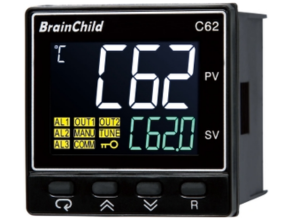Description
Brainchild’s C62 controller is a cost-effective solution for regulating industrial temperatures and processes. PID technology, which has proven to be reliable and popular in various industries, is at the heart of this controller. PID was chosen for its outstanding ability to efficiently manage various types of control systems. In fact, almost all industrial control systems today rely on PID due to its simplicity, flexibility, and ease of use.

The C62 comes with the latest innovation, the integration of fuzzy logic with a microprocessor. This combination results in more precise and responsive temperature control. Two intuitive LCD displays make it easy for users to monitor actual process values and desired values. The fuzzy logic technology ensures the process reaches the set temperature quickly and stably, minimizing unwanted fluctuations, both when first switched on and when changes in operating conditions occur.
Description:
- High quality LCD Display
- High Accuracy 18 Bit A-D Input and 15 Bit D-A Output
- The Fast Sampling Rate in 200msec
- True Universal Inputs of Thermocouple, RTD, mA, V
- Fuzzy+ PID Control
- Auto-Tuning
- Possibility of both RS-485 and Analog Retransmission
- CT Inputs for Heater-Break Detection
- Upto 6 Event Inputs
- Remote Setpoint
- Bumpless Transfer
- Lockout Protection
- Bidirectional Menu Navigation
Specification:

| Power? | |
| Power supply | 90 to 250?VAC, 47–63?Hz ; 11 to 40?VDC / 20 to 28 VAC, 47–?63 Hz |
| Power consumption | 10VA, 5W maximum |
| Signal Input | |||||||||||||||||||||||||||||||||||||||||||||||||||||||||||||||||||||||||
| Type | Thermocouple(J,K,T,E,B,R,S,N,L,U,P,C,D), RTD(PT100(DIN), PT100(JIS)), Current(mA),Voltage(Volts) | ||||||||||||||||||||||||||||||||||||||||||||||||||||||||||||||||||||||||
| Resolution | 18 Bits | ||||||||||||||||||||||||||||||||||||||||||||||||||||||||||||||||||||||||
| Sampling rate | 5 Times / Second (200msec) | ||||||||||||||||||||||||||||||||||||||||||||||||||||||||||||||||||||||||
| Maximum rating | -2VDC minimum, 12VDC maximum | ||||||||||||||||||||||||||||||||||||||||||||||||||||||||||||||||||||||||
| Input characteristics |
| ||||||||||||||||||||||||||||||||||||||||||||||||||||||||||||||||||||||||
| Temperature effect | 1.5µV /°C for all inputs except mA input, 3.0µV /°C for mA | ||||||||||||||||||||||||||||||||||||||||||||||||||||||||||||||||||||||||
| Sensor lead resistance effect | Thermocouple: 0.2 µV /?; 3-wire RTD: 2.6°C /? of Difference of Resistance of two leads 2-wire RTD: 2.6°C /? of Sum of Resistance of two leads | ||||||||||||||||||||||||||||||||||||||||||||||||||||||||||||||||||||||||
| Burn-out current | 200nA | ||||||||||||||||||||||||||||||||||||||||||||||||||||||||||||||||||||||||
| Common mode rejection ratio(CMRR) | 120 dB | ||||||||||||||||||||||||||||||||||||||||||||||||||||||||||||||||||||||||
| Normal mode rejection ratio (NMRR) | 55 dB | ||||||||||||||||||||||||||||||||||||||||||||||||||||||||||||||||||||||||
| Sensor break detection | Sensor open for Thermocouple and RTD inputs, sensor short for RTD input , below 1mA for 4-20mA input, below 0.25V for 1-5V input, not available for other inputs | ||||||||||||||||||||||||||||||||||||||||||||||||||||||||||||||||||||||||
| Sensor break responding time | Within 4 seconds for Thermocouple and RTD inputs, 0.1 second for 4-20mA and 1-5V inputs | ||||||||||||||||||||||||||||||||||||||||||||||||||||||||||||||||||||||||
| Remote Set Point Input | |
| Type | Linear Current, Linear Voltage |
| Range | -3mA to 27mA, -1.3V to 11.5V |
| Accuracy | ±0.05 % |
| Remote set point option | Not Available |
| Input impedance | Current: 2.5?, Voltage:1.5M? |
| Resolution | 18 Bits |
| Sampling rate | 1.66 Times/Second |
| Maximum rating | 280mA maximum for Current Input, 12VDC maximum for Voltage Input |
| Temperature effect | ±1.5µV/°C for Voltage Input , ±3.0µV/°C for Current Input |
| Sensor break detection | Below 1mA for 4-20mA input, below 0.25V for 1-5V input, not available for other inputs |
| Sensor break responding Time | 0.1 Seconds |
| Event Input | |
| No. of event Inputs | 2 |
| Logic low | -10V minimum, 0.8V maximum. |
| Logic high | 2V minimum, 10V maximum |
| Functions | Refer to user manual |
| Analog Retransmission | |
| Output signal | 4-20 mA, 0-20 mA, 0 – 10V |
| Resolution | 15 Bits |
| Accuracy | ±0.05% of Span ± 0.0025% / °C |
| Load resistance | 0 to 500? for current output, 10K? minimum for voltage output |
| Output regulation | 0.01% for full load change |
| Output setting time | 0.1 second (stable to 99.9%) |
| Isolation breakdown | 1000VAC minimum |
| Integral linearity error | ±0.005% of span |
| Temperature effect | ±0.0025% of span /°C |
| Saturation low | 0mA or 0V |
| Saturation high | 22.2mA or 5.55V, 11.1V min |
| Linear output ranges | 0 – 22.2mA (0 – 20mA/4 – 20mA), 0 – 5.55V (0 – 5V, 1 – 5V), 0 – 11.1V (0 – 10V) |
| Data Communication | |
| Interface | RS-485 |
| Protocol | Modbus RTU (Slave Mode) |
| Address | 1 to 247 |
| Baudrate | 2.8 KBPS to 115.2 KBPS |
| Parity bit | None, Even or Odd |
| Stop bit | 1 or 2 Bits |
| Data length | 7 or 8 Bits |
| Communication buffer | 160 Bytes |
| Approval Standards | |
| Safety | UL61010-1, EN61010-1 (IEC1010-1), RoHS, REACH |
| Protective class | IP50 for Panel, IP20 for terminals and housing, all indoor use |
| EMC | EN61326 |
For More Information & Price: Brainchild C62 Low-cost Process and Temperature Controllers
Read More Articles:
- Hengesbach TP 51 Compact Resistance Thermometer
- Hengesbach TP 50 Compact Resistance Thermometer
- Hengesbach Resistance Thermometer with Screw Connection TP 26
- Tube Resistance Thermometer TP 21 Hengesbach
- Hengesbach TP 19 Flange Resistance Thermometer




